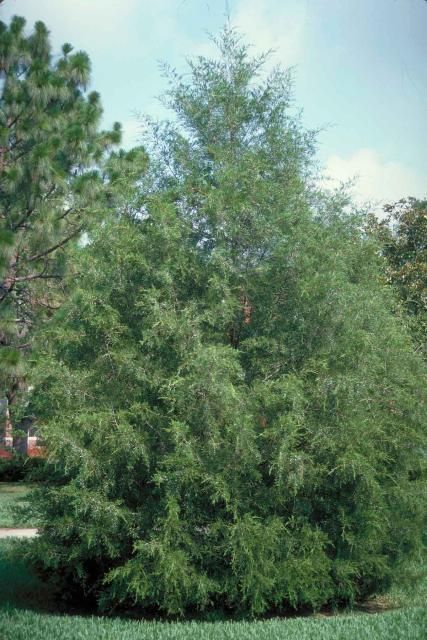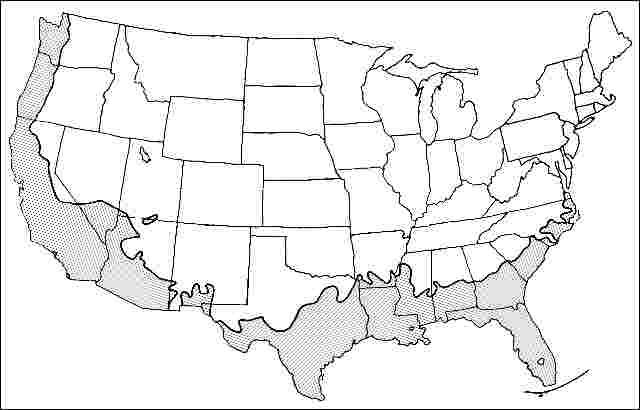Introduction
This densely-foliated, wide pyramidal, columnar or oval evergreen grows fairly quickly, ultimately reaching heights up to 40 feet with a 25-foot spread. Some individual plants grow wider than tall as they grow older. Some botanists do not make a distinction between Juniperus silicicola and Juniperus virginiana. Its fine-textured, medium green leaves, and drooping branchlets help to soften the rather symmetrical, oval juvenile form. Mature specimens of Southern Redcedar take on a flat-topped, almost windswept appearance, making them very picturesque. Bark and trunk on older specimens take on a delightful, 'old-tree' look.

Credit: Ed Gilman, UF/IFAS
General Information
Scientific name: Juniperus silicicola
Pronunciation: joo-NIP-er-us sill-liss-sih-KOLE-uh
Common name(s): Southern Redcedar
Family: Cupressaceae
USDA hardiness zones: 8A through 10B (Fig. 2)
Origin: native to North America
Invasive potential: little invasive potential
Uses: urban tolerant; screen; street without sidewalk; reclamation; tree lawn 3-4 feet wide; tree lawn 4-6 feet wide; tree lawn > 6 ft wide; highway median; bonsai; Christmas tree
Availability: not native to North America

Description
Height: 30 to 45 feet
Spread: 20 to 30 feet
Crown uniformity: symmetrical
Crown shape: pyramidal, columnar, oval
Crown density: open
Growth rate: fast
Texture: fine
Foliage
Leaf arrangement: opposite/subopposite (Fig. 3)
Leaf type: simple
Leaf margin: entire, terminal spine
Leaf shape: awl-like, scale-like
Leaf venation: none, or difficult to see
Leaf type and persistence: evergreen
Leaf blade length: less than 2 inches
Leaf color: green
Fall color: no color change
Fall characteristic: not showy

Flower
Flower color: unknown
Flower characteristics: not showy
Fruit
Fruit shape: cone, round
Fruit length: less than .5 inch
Fruit covering: fleshy
Fruit color: purple, blue
Fruit characteristics: attracts birds; showy; fruit/leaves not a litter problem
Trunk and Branches
Trunk/bark/branches: branches droop; showy; typically one trunk; thorns
Pruning requirement: little required
Breakage: susceptible to breakage
Current year twig color: green, brown
Current year twig thickness: thin
Wood specific gravity: unknown
Culture
Light requirement: full sun, partial sun, or partial shade
Soil tolerances: clay; sand; loam; alkaline; acidic; well-drained
Drought tolerance: high
Aerosol salt tolerance: high
Other
Roots: not a problem
Winter interest: no
Outstanding tree: no
Ozone sensitivity: unknown
Verticillium wilt susceptibility: resistant
Pest resistance: free of serious pests and diseases
Use and Management
The dense growth and attractive foliage make Southern Redcedar a favorite for windbreaks, screens, and wildlife-cover for large-scale landscapes. Its high salt-tolerance makes it ideal for seaside locations. Redcedar can make a nice Christmas tree, and the fragrant wood is popular for repelling insects. Cedar Key, FL, once had extensive redcedar forests before the lumber was extensively harvested and the wood used for chests and pencils. Although not currently used often as a street tree, its wood is strong, the foliage is clean, and the fruit is small making it a suitable candidate. There are some nice examples of street tree use in southern cities. With proper pruning to remove lower branches, it should adapt well to street-scapes.
Planted in full sun or partial shade, Southern Redcedar will easily grow on a variety of soils, including clay. Growth may be poor in landscapes which are over-irrigated. Plants are difficult to transplant due to a coarse root system, except when quite small. Water until well-established and then forget about the tree. It performs admirably with no care, even on alkaline soil and along the coast. Usually insects and diseases are not a problem if grown in the full sun. There may be local restrictions on planting this tree near apple orchards because it is the alternate host for cedar-apple rust.
Propagation is by seed, which germinate faster if planted as soon as the cones mature or if given a stratification period. Also, tip cuttings can be rooted.
No cultivars are listed but there is ample opportunity to propagate and culture from the wide diversity of shapes and growth habits exhibited by this tree.
Pests
Usually none are serious.
Bagworm caterpillars web foliage and debris together to make bags up to two inches long. The insects live in the bags and emerge to feed on the foliage. Use sprays of Bacillus thuringiensis. The insects can also be picked off the plants by hand.
Juniper scale causes yellowed needles, and infected branches fail to produce new growth. The scale is round and at first white, later turning gray or black.
The Juniper webworm webs twigs and needles together, causing them to brown and die. The larva is 1/2-inch-long and is brown with darker stripes. The larvae are often in the densest part of the plant and can go unnoticed.
Mites cause stippled and bronzed foliage.
Diseases
Twig blights cause death and browning of twigs tips. The diseases may progress down the stem killing the whole branch. Small lesions may be seen at the base of dead tissue. Prune out dead branch tips. Dieback from Kabatina blight appears in early spring, from Phomopsis in summer.
Three rust diseases seen most often are cedar-apple rust, hawthorn rust, and quince rust. The most common is cedar-apple rust. On Juniper the disease forms galls and orange jelly-like horns in spring. The horns are most likely to form following periods of rainy, warm weather. Spores formed in the horns infect the alternate host. The diseases are more serious on the alternate host than Juniper. A separation of a few hundred yards may help avoid the disease. Prune out the spore horns when seen in the spring.
Junipers are not tolerant of ice coatings. Expect dieback when Junipers are covered with ice for several days. Removing the ice is impractical.